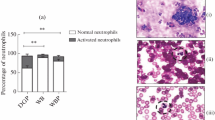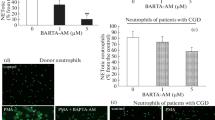Abstract
Behcet’s disease (BD) is a chronic, inflammatory, and multisystemic condition although its pathogenesis is uncertain. Main component of St. John’s wort (Hypericum perforatum, HP) is hyperforin and induces antiinflammatory and antioxidant properties. We aimed to investigate effects of HP on oxidative stress, apoptosis, and cytosolic-free Ca2+ [Ca2+]i concentration in neutrophil of BD patients. Nine new-diagnosed active patients with BD and nine control subjects were included in the study. Disease activity was considered by clinical findings. Neutrophil samples were obtained from the patients and controls. The neutrophils from patients were divided into three subgroups and were incubated with HP, voltage-gated calcium channel (VGCC) blockers, (verapamil+dilitiazem) and non-specific TRPM2 channel blocker (2-aminoethyl diphenylborinate, 2-APB), respectively. The neutrophils were stimulated by fMLP as a Ca2+-concentration agonist and oxidative stress former. Caspase-3, caspase-9, apoptosis, lipid peroxidation, and [Ca2+]i values were high in the patient groups, although cell viability, glutathione (GSH), and glutathione peroxidase (GSH-Px) values were low in patient group. However, the [Ca2+]i, caspase-3, and caspase-9 values decreased markedly in patient+HP group although GSH and GSH-Px values increased in the group. The [Ca2+]i concentration was also decreased in the patient group by V+D, 2-APB, and HP incubations. In conclusion, we observed the importance of neutrophil Ca2+ entry, apoptosis, and oxidative stress through gating VGCC and TRPM2 channels in the neutrophils in the pathogenesis and activation of the patients with BD. HP induced protective effects on oxidative stress by modulating Ca2+ influx in BD patients.
Graphical Abstract







Similar content being viewed by others
Abbreviations
- 2-APB:
-
2-Aminoethyl diphenylborinate
- BD:
-
Behcet’s disease
- CRP:
-
C-reactive protein
- ESR:
-
Erythrocyte sedimentation rate
- fMLP:
-
N-Formyl-l-methionyl-l-leucyl-l-phenylalanine
- GSH:
-
Reduced glutathione
- GSH-Px:
-
Glutathione peroxidase
- MDA:
-
Malondialdehyde
- MPO:
-
Myeloperoxidase
- ROS:
-
Reactive oxygen species
- SOD:
-
Superoxide dismutase
- TRPM2:
-
Transient receptor potential melastatin 2
- V+D:
-
Verapamil+diltiazem
- VGCC:
-
Voltage-gated calcium channels
References
Ayub K, Hallett MB (2004) Ca2+ influx shutdown during neutrophil apoptosis: importance and possible mechanism. Immunology 1:8–12
Behcet H (1937) Uber rezidivierende Aphthose, durch ein Virus verursachte Geschwure am Mund, am Auge und an den Genitalien. Dermatol Wochenschr 105:1152–1157
Bréchard S, Tschirhart EJ (2008) Regulation of superoxide production in neutrophils: role of calcium influx. J Leukoc Biol 84:1223–1237
Chatterjee S, Filippov V, Lishko P, Maximyuk O, Nöldner M, Krishtal O (1999) Hyperforin attenuates various ionic conductance mechanisms in the isolated hippocampal neurons of rat. Life Sci 65:405–2395
Direskeneli H (2001) Behçet’s disease: infectious aetiolog, new autoantigens, and HLA-B51. Ann Rheum Dis 60:996–1002
Erkiliç K, Evereklioglu C, Cekmen M, Ozkiris A, Duygulu F, Dogan H (2003) Adenosine deaminase enzyme activity is increased and negatively correlates with catalase, superoxide dismutase and glutathione peroxidase in patients with Behçet’s disease: original contributions/clinical and laboratory investigations. Mediators Inflamm 12:107–116
Espino J, Mediero M, Bejarano I, Lozano GM, Ortiz A, García JF, Pariente JA, Rodríguez AB (2009) Reduced levels of intracellular calcium releasing in spermatozoa from asthenozoospermic patients. Reprod Biol Endoc 7:11
Espino J, Bejarano I, Redondo PC, Rosado JA, Barriga C, Reiter RJ, Pariente JA, Rodríguez AB (2010) Melatonin reduces apoptosis induced by calcium signaling in human leukocytes: evidence for the involvement of mitochondria and Bax activation. J Membr Biol 233:105–118
Espino J, Bejarano I, Paredes SD, Barriga C, Rodríguez AB, Pariente JA (2011) Protective effect of melatonin against human leukocyte apoptosis induced by intracellular calcium overload: relation with its antioxidant actions. J Pineal Res 51:195–206
Evereklioglu C (2005) Current concepts in the etiology and treatment of Behcet disease. Surv Ophthalmol 50:297–350
Feisst C, Werz O (2004) Suppression of receptor-mediated Ca2+ mobilization and functional leukocyte responses by hyperforin. Biochem Pharmacol 67(8):1531–1539
Grynkiewicz C, Poenie M, Tsien RY (1985) A new generation of Ca2+ indicators with greatly improved fluorescence properties. J Biol Chem 260:3440–3450
Heemskerk JW, Feijge MA, Henneman L, Rosing J, Hemker HC (1997) The Ca2+-mobilizing potency of alpha-thrombin and thrombin receptor-activating peptide on human platelets concentration and time effects of thrombin-induced Ca2+ signalling. Eur J Biochem 249:55–547
Heilmann J, Winkelmann K, Sticher O (2003) Studies on the antioxidative activity of phloroglucinol derivatives isolated from hypericum species. Planta Med 69:202–226
Heiner I, Eisfeld J, Luckhoff A (2003) Role and regulation of TRP channels in neutrophil granulocytes. Cell Calcium 33:533–540
Jang MH, Lee TH, Shin MC, Bahn GH, Kim JW, Shin DH, Kim EH, Kim CJ (2002) Protective effect of Hypericum perforatum Linn (St. John’s wort) against hydrogen peroxide-induced apoptosis on human neuroblastoma cells. Neurosci Lett 329:177–180
Karaman A, Kadi M, Kara F (2009) Sister chromatid exchange and micronucleus studies in patients with Behçet's disease. J Cutan Pathol 36:831–837
Kökçam I, Nazıroglu M (2002) Effects of vitamin E supplementation on blood antioxidants levels in patients with Behçet’s diseas. Clin Biochem 35:633–639
Korkmaz S, Erturan İ, Nazıroğlu M, Uğuz AC, Çiğ B, Övey İS (2011) Colchicine modulates oxidative stress in serum and leucocytes of patients with Behcet’s disease through regulation of Ca2+ release and antioxidant system. J Membr Biol 244:113–120
Krishtal O, Lozovaya N, Fisunov A, Tsintsadze T, Pankratov Y, Kopanitsa M, Chatterjee SS (2001) Modulation of ion channels in rat neurons by the constituents of Hypericum perforatum. Pharmacopsychiatry 34(Suppl 1):S74–S82
Lawrence RA, Burk RF (1976) Glutathione peroxidase activity in selenium-deficient rat liver. Biochem Biophys Res Commun 71:952–958
Lin Y, Zhang JC, Fu J, Chen F, Wang J, Wu ZL, Yuan SY (2013) Hyperforin attenuates brain damage induced by transient middle cerebral artery occlusion (MCAO) in rats via inhibition of TRPC6 channels degradation. J Cereb Blood Flow Metab 33(2):62–253
Lowry OH, Rosebrough NJ, Farr AL, Randall RJ (1951) Protein measurement with the folin–phenol reagent. J Biol Chem 193:265–275
Meinke MC, Schanzer S, Haag SF, Casetti F, Müller ML, Wölfle U, Kleemann A, Lademann J, Schempp CM (2012) In vivo photoprotective and anti-inflammatory effect of hyperforin is associated with high antioxidant activity in vitro and ex vivo. Eur J Pharm Biopharm 81(2):346–350
Nazıroğlu M (2007) New molecular mechanisms on the activation of TRPM2 channels by oxidative stress and ADP-ribose. Neurochem Res 32:1990–2001
Nazıroğlu M (2009) Role of selenium on calcium signaling and oxidative stress- induced molecular pathways in epilepsy. Neurochem Res 34:219–2181
Nazıroğlu M (2011) TRPM2 cation channels, oxidative stress and neurological diseases: where are we now? Neurochem Res 36:355–366
Nazıroğlu M, Karaoğlu A, Aksoy AO (2004) Selenium and high dose vitamin E administration protects cisplatin-induced oxidative damage to renal, liver and lens tissues in rats. Toxicology 195(2–3):30–221
Nazıroğlu M, Özgül M, Çiğ B, Doğan S, Uğuz AC (2011) Glutathione and 2-aminoethoxydiphenyl borate modulate Ca2+ influx and oxidative stress through TRPM2 channel in rat dorsal root ganglion neurons. J Membr Biol 242(3):18–109
Nazıroğlu M, Dikici DM, Dursun S (2012) Role of oxidative stress and Ca2+ signaling on molecular pathways of neuropathic pain in diabetes: focus on TRP channels. Neurochem Res 37:75–2065
Nazıroğlu M, Çiğ B, Özgül C (2013) Neuroprotection induced by N-acetylcysteine against cytosolic glutathione depletion induced-Ca2+ influx in dorsal root ganglion neurons of mice: role of TRPV1 channels. Neuroscience 242:151–160
Nazıroğlu M, Çiğ B, Özgül C (2014a) Modulation of oxidative stress and Ca2+ mobilization through TRPM2 channels in rat dorsal root ganglion neuron by Hypericum perforatum. Neuroscience. doi:10.1016/j.neuroscience.2014.01.006
Nazıroğlu M, Kutluhan S, Övey İS, Aykur M, Yurekli VA (2014b) Modulation of oxidative stress, apoptosis, and calcium entry in leukocytes of patients with multiple sclerosis by Hypericum perforatum. Nutr Neurosci. doi:10.1179/1476830513Y.0000000083
Öztaş P, Lortlar N, Polat M, Allı N, Ömeroğlu S, Basman A (2007) Caspase-9 expression is increased in endothelial cells of active Behçet’s disease patients. Intern J Dermatol 46:172–176
Placer ZA, Cushman L, Johnson BC (1966) Estimation of products of lipid peroxidation (malonyl dialdehyde) in biological fluids. Anal Biochem 16:359–364
Şahin M, Uguz AC, Demirkan H, Naziroglu M (2011) Colchicine modulates oxidative stress in serum and leucocytes from remission patients with Family Mediterranean Fever through regulation of Ca(2)+ release and the antioxidant system. J Membr Biol 240:55–62
Sandikci R, Türkmen S, Güvenen G, Ayabakan H, Gülcan P, Koldas M, Ozbek Kir Z, Yenice N (2003) Lipid peroxidation and antioxidant defence system in patients with active or inactive Behcet’s disease. Acta Derm Venereol 83:6–342
Sedlak J, Lindsay RHC (1968) Estimation of total, protein bound and non-protein sulfhydryl groups in tissue with Ellmann’ s reagent. Anal Biochem 25:192–205
Shima E, Katsube M, Kato T, Kitagawa M, Hato F, Hino M, Takahashi T, Fujita H, Kitagawa S (2008) Calcium channel blockers suppress cytokine-induced activation of human neutrophils. Am J Hypertens 21:78–84
Tamer A, Gheita TA, Bassyouni IH, Bassyouni RH (2012) Plasma concentrations of growth arrest specific protein 6 and the soluble form of its tyrosine kinase receptor Axl in patients with systemic lupus erythematosus and Behçets disease. J Clin Immunol 32:1279–1286
Taysi S, Kocer I, Memisogullari R, Kiziltunc A (2002) Serum oxidant/antioxidant status in patients with Behcet’s disease. Ann Clin Lab Sci 2002(32):82–377
Todaro M, Zerilli M, Triolo G, Flora Iovino F, Patti M, Accardo-Palumbo A, di Gaudio F, TurcoPetrella MC, Petrella A, de Maria R, Stassi G (2005) NF-kB protects Behcet’s disease T cells against CD95-induced apoptosis up-regulating antiapoptotic proteins. Arthritis Rheum 52:2179–2191
Uğuz AC, Nazıroğlu M, Espino J, Bejarano I, Gonza′lez D, Rodrı′guez AB, Pariente JA (2009) Selenium modulates oxidative stressinduced cell apoptosis in human myeloid HL-60 cells via regulation of caspase-3, -9 and calcium influx. J Membr Biol 232:15–23
Uğuz AC, Cig B, Espino J, Bejarano I, Naziroglu M, Rodríguez AB, Pariente JA (2012) Melatonin potentiates chemotherapy-induced cytotoxicity and apoptosis in rat pancreatic tumor cells. J Pineal Res 53:91–98
Uğuz AC, Nazıroğlu M (2012) Effects of selenium on calcium signaling and apoptosis in rat dorsal root ganglion neurons induced by oxidative stress. Neurochem Res 37:1631–1638
Acknowledgments
MN formulated the present hypothesis and was responsible for writing the report. BÇ and MA were responsible from analysis. Blood samples and detection of the disease were performed by MŞ, İE, and YU. The study was partially supported by Unit of Scientific Research Project, Suleyman Demirel University (NO: BAP: 2526-M-10).
Author information
Authors and Affiliations
Corresponding author
Rights and permissions
About this article
Cite this article
Nazıroğlu, M., Şahin, M., Çiğ, B. et al. Hypericum perforatum Modulates Apoptosis and Calcium Mobilization Through Voltage-Gated and TRPM2 Calcium Channels in Neutrophil of Patients with Behcet’s Disease. J Membrane Biol 247, 253–262 (2014). https://doi.org/10.1007/s00232-014-9630-7
Received:
Accepted:
Published:
Issue Date:
DOI: https://doi.org/10.1007/s00232-014-9630-7




